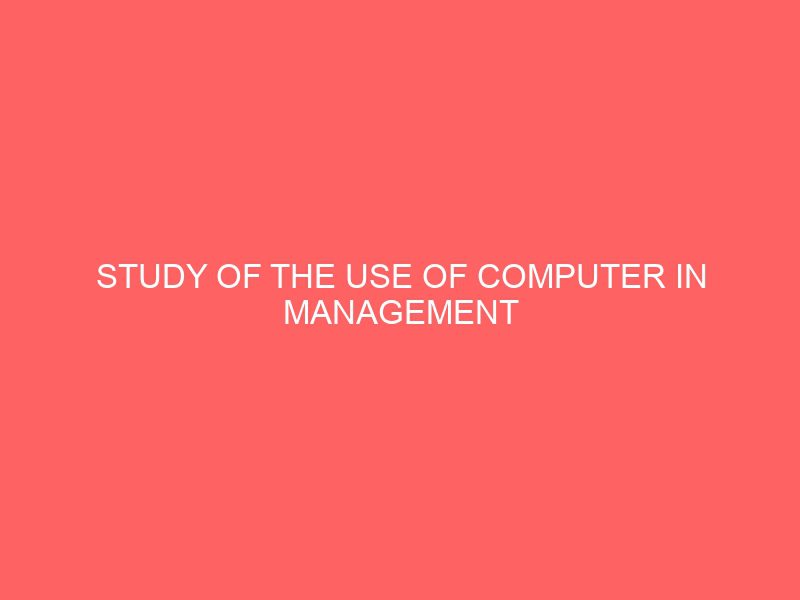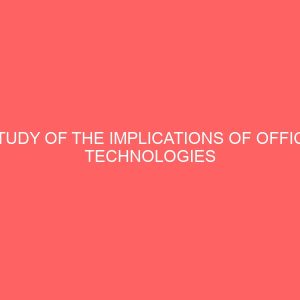Description
STUDY OF THE USE OF COMPUTER IN MANAGEMENT INFORMATION SYSTEM (Case Study Of First Bank Plc, Enugu)
In the preliminary chapter, effects were made by the researcher to identify some of the use of computer in management international system which were largely treated in chapter two.
The researcher wades in to find out how for the management information system facilitated the information flow in first Bank Plc, Enugu.
In chapter two, the view the various writer scholars was educationists that were relative to the topic were started and reviewed.
Question item were used to collect information for the respondents which were analysis by simple percentage.
In chapter three, out of 1q00 were selected and supervised, only 80 returned their question out of the questionnaire distributed.
Also instrument used for data collection, method of data analysis and the sample technique al contained in this chapter.
Chapter four deals with data analysis and interpretative of results which as analysed by simple percentage.
Finally in chapter fine, finding, conclusive recommendation and the references where included
Approval Page
Dedication
Acknowledgement
Abstract
Table Of Contents
Chapter One
1.0 Introduction
1.0.1 History Of First Bank And Its Management Information System
1.1 Statement Of Problem
1.2 Aim/Purpose Of Study
1.3 Significance Of The Study
1.4 Scope Of The Study
1.5 Research Question
Chapter Two
2.1 History Of Management Information System
2.2 The Major Area Of Computer Appliances In First Bank
2.3 The Personnel Information System
2.4 The First Bank Financial Information System
Chapter Three
3.0 Research Methodology
3.1 Research Design
3.2 Area Of The Study
3.3 Population Of The Study
3.4 Sample And Sampling Procedure
3.5 Instrument For Data
3.6 Reliability Of The Instrument
3.7 Method Of Data Collected
3.8 Method Of Data AnalysisChapter Four
4.0 Data Analysis
4.1 Research Question
Chapter Five
5.0 Summary Of Findings, Conclusion And Recommendation
5.1 Summary Of Findings
5.2 Conclusion
5.3 Recommendation
5.4 Suggestion For Further Research
Reference
Bibliography
Questionnaire
INTRODUCTION
Computer has become a very powerful tool in the business world today because of its ability to store, process and disseminate large amount of information accurately, efficiently and effectively for quick decision.
According to Ani (200:5A), computer can be defined as an electronic tool capable of accepting data, interpreting data, performing ordered operation on data and reporting on the outcome of these operation. It is therefore a tool managers can use to assist them in the complicated and time consuming task of generating information.
The computer took many centuries to come to the age of four generation, reckoning from time, serious efforts began towards simplifying mathematical computations Quite a few people were involved in the development of the computer and several of the scientists who made those useful contributions did not really aim at developing a computer but their inventions turned out to be an important step towards the development of computer
According to Alan Trunning (1937) showed that a computer can be built with a set of simple instruction while any problem having a logical solution can be reduced to a solution based upon a small set of simple instruction. A few years later, John Von Neuman (1946) set out a summary of the design requirement far a modern computer as follows:-
1. The processing of data instructions which include the use of modification of programs.
2. Binary codes is used to represent data and instruction in a way that makes no distinction of the two and still allow them the storage space in the computer.
Based on those contributions and innovations of these scientists and others, the modern computer came to be. IT underwent series of improvement which gave rise to farth computer generation, before we have today, MODERN COMPUTER.
However, the introduction of this general purpose device and machine and simple programming languages greatly increased the computer utility especially in management information system (MIS) which basically deals on how information is obtained, retrieved and utilized. Computers are now indispensable tools in any business activities because electronic data processing is growing and meeting the expected need of people’s speed, accuracy and efficiency in handling of data and security. IT also extended to other areas such as marketing, accounting, inventory management and production process.
According to Lutter Quick (1954) The concept of management information system (MIS) was formulated by Lutter Quick whole delivering a speech in October, 1960 at Ihe Rochester Institute of Technology, their are then it become obvious and necessary that information should play a vital role in the solution of business and management problems in a price-meal fashion thereby focusing almost entirely on the mechanization of all office chores.
Basically, Management Information System attempt to provide managers at all levels with the information they need to guide their enterprises. It provides an organization with flexible integrated tool for the planning and control function of their endeavours, with the ability to planned and unplanned information requirement at all management levels.
According to Onuigbo (1990:487) Management information System (MIS) is he formal processing and dispersing of information in internal and external within the organization in an effective and efficient manner.
Primarily, the management information system (MIS) is set up of the purpose of providing, planning and controlling information to all levels of management to effect appropriate decision making. Thus, it does this by gathering data, inputting and processing them into information and further dissemination these items of information, we can therefore, say that management information system can be sub-divided into functional information system such as marketing information system, Ihe financial information system and Ihe personnel information system and so on depending on the type of organization.
The management information system provides managements with varying information depending on the level, thereby making increased in the efficiency of the organization through better management decisions.
However, owing to the fact that organizations have grown in sizes, information flow has become so voluminous that face to face communication and even writing memoranda can no longer effect adequate communication or effective processing of data. The management information system of these organizations have in recent times fond it difficult to meet with The increasing demand being made on information as a result, The manual means o operation is Jam-packet with scored of data to be processed. Hence delay and inaccuracies in data collection and analysis. Delay often makes decision making to be inaccurate. Also, there is problem of misappropriation of important document of files or even cases of stolen files.
HISTORY OF FIRST BANK AND ITS MANAGEMENT INFORMATION SYSTEM
First Bank of Nigeria Plc, was founded in 1894 by a shipping magnate form Liverpool, Sir Alfred Jones, the Bank commenced as a small operation in the office of Elder Dempster and Company in Lagos.
The Bank was incorporated as a limited liability company on March 31, 1894, with Head Office in Liverpool. It started business under the corporate name of the Bank for British West African (BBWA) with a paid up capital of 12,000 pounds starting, after absorbing its predecessor, Ihe Africa Banking Corporation, which was established earlier in 1892. This signaled the pre-eminent position which the Bank was to establish in the banking industrial in West Africa. In the early years of operations, Ihe bank recorded an impressive growth and worked closely with the colonial Government in performing the traditional functions of a Central Bank, such as issue of specie in the West Africa sub region.
To justify its west Africa coverage, a branch was opened in Accra, Gold coast (now Aghana) in 1896 and another in Freetown, Sierra Leone in 1898. These marked Ihe genesis of the Bank’s international banking operations. The second branch of the Bank in Nigeria was in the old Calabar in 1960 and two years later services were extended to Northern Nigeria.
To satisfy the needs of its customers, first bank has diversified into a wide range of Banking activities and services. The include corporate, Retail and Mortgage Banking, Registrar ship private equity financing, trusteeship and Insurance Brokerage. In addition as part of its strategy of progressive internationalization, in November 2002, Ihe Bank become the first financial institution in Nigeria to establish a subsidiary bank in the United Kingdom.
Over the year, Ihe Bank has experienced phenomenal growth. With a share capital of N53.6 million in 1980, Ihe Banks share capital grew to N1.270 billion as at march 2003.
The Banks total asset base was N320.58 billion while its deposit base stood at N193.955 billion as at March 2003. Also, Ihe Bank’s market capitalization stood at N66.05 billion i.e N25.00k per share as at 31st March 2003.
IN 1957, it changed its name from Bank of British West African to Bank of West Africa. In 1969, Ihe Bank was incorporated locally as the standard Bank of Nigeria limited in line with the companies Decree of 1968.
Changes in the name of the Banks also occurred in 1979 and 1991, to first Bank of Nigeria limited and first Bank of Nigeria Plc, respectively.
The Bank has continued to be a leader in financing loan term development of the economy which was demonstrated. In 1947 when the first long term loan was advanced to Ihe then colonial Government. To demonstrate its commitment to its customers and Ihe development of the Nigerian economy, Ihe bank has since broadened its loan and credit port-floes the various sectors of the economy.
The Bank has improved tremendously judging from a number of parameters including number of branches, growth in deposit base, asset size and size of loans and advances.
Furthermore, its track record of profitability and reliability in sound banking has continually placed the Bank in its leadership position.
1.1 STATEMENT OF PROBLEM
Many years ago, all business data were processed manually. This was not always a satisfactory method because it was so slow. Most organization in this country have been encountering business information problem because of manual method used. These problems affected their level of performance in terms of output and quality of services.
Furthermore, there are other problems relating to the international structure and functions of the organization which include personnel turnover, loss of records, expensive communication, equipment, record, storage system problem such as collection, processing, storage and retrial and distribution of information which play a vital role in the decision making processes.
The first Bank personnel have in Ihe past been denied of the gadget with modern technology to aid them in enhancing efficient and effective service in discharging their professional carrier.
It is in the light of the awareness that Ihe researcher chose Ihe topic A study of computer in management information system to solve the problem of ineffective information system which bugged organization far many years.
1.2 THE AIM/PURPOSE OF STUDY
The aim of this study is
1. To determine to what extent management information system has facilitated information flow in First Bank Plc, Enugu.
2. To determine if there are lapses in the management information system in First Bank PLC, Enugu.
3. To find out the contributions of management information system towards Ihe achievement of First Bank’s goal?
1.3 SIGNIFICANCE OF THE STUDY
The study will be most useful to First Bank Plc, Enugu. It will be also be useful to individual, public sectors, state and federal government establishment that uses computer on management information system.
It will also serve as a data bank for future research on mis and addition to materials already existing in the library. The study will also be of much significant important to institutions that offer management information system as a course and Ihe establishment that may like to open the union on management information system.
It will also remedy the force found on those already operating Ihe system with some discrepancies.
1.4 SCOPE OF THE STUDY
The study is delimited to the use of computer in Management Information System in First Bank PLC, Enugu.
1.5 RESEARCH QUESTION
The following questions will be used in writing the project:
1. How far has management informative system facilitated the information flow in First Bank PLC, Enugu.
2. What are Ihe lapses in the management information system of First Bank PLC Enugu.
3. What are Ihe contributions of management information system towards Ihe achievement of First Bank’s goal?








Reviews
There are no reviews yet.